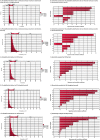Risk of introduction of lumpy skin disease in France by the import of vectors in animal trucks
- PMID: 29889905
- PMCID: PMC5995388
- DOI: 10.1371/journal.pone.0198506
Risk of introduction of lumpy skin disease in France by the import of vectors in animal trucks
Abstract
Background: The lumpy skin disease virus (LSDV) is a dsDNA virus belonging to the Poxviridae family and the Capripoxvirus genus. Lumpy skin diseases (LSD) is a highly contagious transboundary disease in cattle producing major economic losses. In 2014, the disease was first reported in the European Union (in Cyprus); it was then reported in 2015 (in Greece) and has spread through different Balkan countries in 2016. Indirect vector transmission is predominant at small distances, but transmission between distant herds and between countries usually occurs through movements of infected cattle or through vectors found mainly in animal trucks.
Methods and principal findings: In order to estimate the threat for France due to the introduction of vectors found in animal trucks (cattle or horses) from at-risk countries (Balkans and neighbours), a quantitative import risk analysis (QIRA) model was developed according to the international standard. Using stochastic QIRA modelling and combining experimental/field data and expert opinion, the yearly risk of LSDV being introduced by stable flies (Stomoxys calcitrans), that travel in trucks transporting animals was between 6 x 10-5 and 5.93 x 10-3 with a median value of 89.9 x 10-5; it was mainly due to the risk related to insects entering farms in France from vehicles transporting cattle from the at-risk area. The risk related to the transport of cattle going to slaughterhouses or the transport of horses was much lower (between 2 x 10-7 and 3.73 x 10-5 and between 5 x 10-10 and 3.95 x 10-8 for cattle and horses, respectively). The disinsectisation of trucks transporting live animals was important to reduce this risk.
Conclusion and significance: The development of a stochastic QIRA made it possible to quantify the risk of LSD being introduced in France through the import of vectors that travel in trucks transporting animals. This tool is of prime importance because the LSD situation in the Balkans is continuously changing. Indeed, this model can be updated to process new information on vectors and the changing health situation, in addition to new data from the TRAde Control and Expert System (TRACES, EU database). This model is easy to adapt to different countries and to other vectors and diseases.
Conflict of interest statement
The authors have declared that no competing interests exist.
Figures




Similar articles
-
Epidemiological Risk Factors and Modelling Approaches for Risk Assessment of Lumpy Skin Disease Virus Introduction and Spread: Methodological Review and Implications for Risk-Based Surveillance in Australia.Transbound Emerg Dis. 2024 May 2;2024:3090226. doi: 10.1155/2024/3090226. eCollection 2024. Transbound Emerg Dis. 2024. PMID: 40303055 Free PMC article. Review.
-
Risk of introduction of Lumpy Skin Disease into France through imports of cattle.Transbound Emerg Dis. 2019 Mar;66(2):957-967. doi: 10.1111/tbed.13111. Epub 2019 Feb 5. Transbound Emerg Dis. 2019. PMID: 30578746
-
High relative abundance of the stable fly Stomoxys calcitrans is associated with lumpy skin disease outbreaks in Israeli dairy farms.Med Vet Entomol. 2017 Jun;31(2):150-160. doi: 10.1111/mve.12217. Epub 2016 Dec 15. Med Vet Entomol. 2017. PMID: 27976815
-
Evidence of Lumpy Skin Disease Virus Transmission from Subclinically Infected Cattle by Stomoxys calcitrans.Viruses. 2023 May 30;15(6):1285. doi: 10.3390/v15061285. Viruses. 2023. PMID: 37376585 Free PMC article.
-
Transmission of lumpy skin disease virus: A short review.Virus Res. 2019 Aug;269:197637. doi: 10.1016/j.virusres.2019.05.015. Epub 2019 May 29. Virus Res. 2019. PMID: 31152757 Review.
Cited by
-
Epidemiological Risk Factors and Modelling Approaches for Risk Assessment of Lumpy Skin Disease Virus Introduction and Spread: Methodological Review and Implications for Risk-Based Surveillance in Australia.Transbound Emerg Dis. 2024 May 2;2024:3090226. doi: 10.1155/2024/3090226. eCollection 2024. Transbound Emerg Dis. 2024. PMID: 40303055 Free PMC article. Review.
-
Isolation and molecular characterization of lumpy skin disease virus from Tamil Nadu, India during the outbreaks from 2020 to 2022.Virus Genes. 2024 Apr;60(2):159-172. doi: 10.1007/s11262-024-02057-8. Epub 2024 Feb 12. Virus Genes. 2024. PMID: 38347303
-
Evaluation of Serological Tests for Detection of Antibodies against Lumpy Skin Disease Virus.J Clin Microbiol. 2020 Aug 24;58(9):e00348-20. doi: 10.1128/JCM.00348-20. Print 2020 Aug 24. J Clin Microbiol. 2020. PMID: 32434783 Free PMC article.
-
Susceptibility of Mediterranean Buffalo (Bubalus bubalis) following Experimental Infection with Lumpy Skin Disease Virus.Viruses. 2024 Mar 19;16(3):466. doi: 10.3390/v16030466. Viruses. 2024. PMID: 38543831 Free PMC article.
-
Approaches for disease prioritization and decision-making in animal health, 2000-2021: a structured scoping review.Front Vet Sci. 2023 Oct 6;10:1231711. doi: 10.3389/fvets.2023.1231711. eCollection 2023. Front Vet Sci. 2023. PMID: 37876628 Free PMC article.
References
-
- Office International des Epizooties (OIE): Handbook on Import Risk Analysis for Animals and Animal Products- Volume II, World Organisation for Animal Health (OIE), Paris, France, 2004, 126 p.
-
- Tuppurainen E, Oura C: Lumpy skin disease: an emerging threat to Europe, the Middle East and Asia. Transboundary and Emerging Diseases 2012;59, 40–48. doi: 10.1111/j.1865-1682.2011.01242.x - DOI - PubMed
-
- Sameea Yousefi P, Mardani K, Dalir-Naghadeh B, Jalilzadeh-Amin G: Epidemiological Study of Lumpy Skin Disease Outbreaks in North-western Iran. Transbound Emerg Dis. 2016. September 15 doi: 10.1111/tbed.12565 [Epub ahead of print] - DOI - PubMed
-
- Tuppurainen ES, Stoltsz WH, Troskie M, Wallace DB, Oura CA, Mellor PS et al.: A potential role for ixodid (Hard) tick vectors in the transmission of lumpy skin disease virus in cattle. Transbound. Emerg. Dis. 2011;58, 93–104. doi: 10.1111/j.1865-1682.2010.01184.x - DOI - PubMed
-
- Prozesky L, Barnard BJ: A study of the pathology of lumpy skin disease in cattle. Onderstepoort Journal of Veterinary Research 1982;49(3):167–175. - PubMed
MeSH terms
LinkOut - more resources
Full Text Sources
Other Literature Sources

